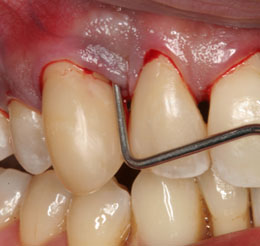 Mouth naturally harbors millions of bacteria. While some are harmless, others can attack the teeth and gums. Harmful bacteria are contained in a colorless sticky film called plaque, which is the primary cause of gum disease. Unattended, plaque builds up on the teeth and ultimately irritates the gums and causes bleeding. Eventually bone and connective tissue are destroyed, and teeth often become loose and may have to be extracted.
Mouth naturally harbors millions of bacteria. While some are harmless, others can attack the teeth and gums. Harmful bacteria are contained in a colorless sticky film called plaque, which is the primary cause of gum disease. Unattended, plaque builds up on the teeth and ultimately irritates the gums and causes bleeding. Eventually bone and connective tissue are destroyed, and teeth often become loose and may have to be extracted.
In the early stages of gingivitis or Gum Disease, the gums can become reddish, swollen and can bleed easily, often during brushing. Bleeding, although not always a symptom of gingivitis, is a signal that your mouth is unhealthy and needs attention. The gums may be irritated, but the teeth are still firmly planted in their sockets. It is also quite likely that no bone or other tissue damage has occurred at this stage.
Smoking
Smoking is one of the most significant risk factors associated with the development of gum disease. Besides, smoking can lower the chances for successful treatment.
Hormonal changes in girls/women.
Hormonal changes which women experience can sometimes make gums more sensitive and make it easier for gingivitis to develop.Diabetes
People who have diabetes are at a higher risk for developing infections, including gum disease.Other illnesses.
Some diseases like cancer or AIDS can affect the health of gums from side effects of their treatments.Medications.
Many prescriptions and over the counter medications can inhibit the flow of saliva, which gives natural protection to the mouth. Without enough saliva, the mouth is vulnerable to infections leading to gum disease. Some medications can trigger abnormal overgrowth of the gum tissue. The additional thickness can make it difficult for keeping teeth and gums clean.Genetic susceptibility
Some people are genetically more prone to severe gum disease than others.- Can create bad breath that won’t go away
- Makes gums red or swollen
- Paves the way for tender or bleeding gums.
- Can make chewing painful.
- Can promote loosening of tooth
- Can make teeth sensitive.
- Can make gums recede and make teeth appear longer.
Periodontal treatment is to control any infection that exists and also to halt its progression. Treatment options involve personal care that includes healthy eating, daily brushing, flossing, and non-surgical therapy that controls the growth of harmful bacteria. In advanced cases of disease, surgery to restore supportive tissues may be necessary.
During a regular checkup your dentist or dental hygienist will remove the plaque and tartar from above and below the gum line of all your teeth. If you have some signs of gingivitis, your dentist may recommend more frequent check-ups, rather than the normal twice a year.
If your dentist finds that you have some bone loss or that the gums have receded from the teeth, the standard treatment is an intensive deep-cleaning, non-surgical method called scaling and root planing (SRP). Scaling scrapes the plaque and tartar from above and below the gum line. Root planing smoothes rough spots on the tooth root where germs collect and helps remove bacteria that can contribute to the disease.

